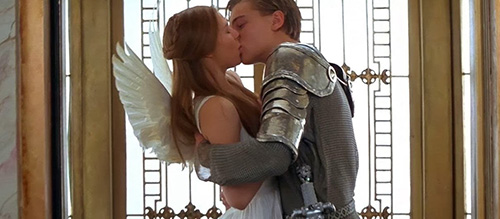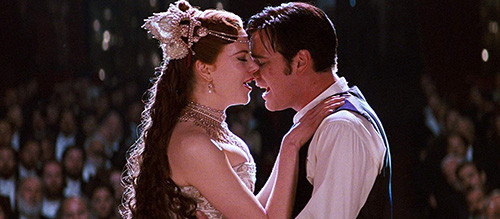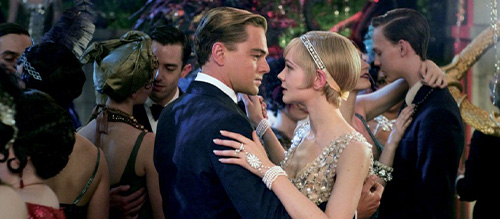Baz Luhrmann’s Iconic Postmodern Trilogy: An Exploration
As Jay Gatsby says… “Can’t repeat the past? Well of course you can!”
This iconic quote from The Great Gatsby reflects Baz Luhrmann’s postmodern style as a filmmaker. Luhrmann is an Australian director renowned for his quirky adaptations, musicals, and his inventive and eccentric auteurship. His most famous, and most postmodernist films, are arguably: William Shakespeare’s Romeo + Juliet (1996), Moulin Rouge (2001) and The Great Gatsby (2013). These films nicely form a postmodern romantic-tragedy trilogy.
Romeo + Juliet is obviously an adaptation of the famous Shakespeare play, but it is so much more than a simple lift from the stage.
Starring Leonardo DiCaprio and Claire Danes, this film is a historic piece which retells the classic tale against a 90s backdrop in Verona Beach, Miami. As is the case with any Shakespeare script, it deals with intense themes and ideas which cleverly correlate with the modern audience as well as they did with their Elizabethan equivalents. DiCaprio and Danes create the perfect image of innocence, beauty, purity and youth whilst also conveying the intense emotions necessary for this iconic story. Luhrmann retains the script but modernises the other elements entirely, such as the bold use of colour and iconography in the mise-en-scene, and the rapid cinematography.
The Sycamore Grove, the iconic decaying arch of an old theatre, is a clever allusion to the originality of the narrative as a play. This inclusion ultimately creates a postmodern mise-en-scene due to the elements of pastiche. This is also reflected in the other elements of façade throughout the film, such as the costume party at the Capulet’s house. An interest thing to pick up on in terms of costume, is that Danes is dressed as an angel and Romeo’s original dialogue is “O, speak again, bright angel”; this is yet another allusion to the past.
Moulin Rouge! also uses pastiche and parody, but this time in musical form.
This film is Luhrmann’s key example of a postmodern musical, which is loosely based on Greek mythology: the story of Orpheus and Eurydice, as well as Puccini’s famed opera “La Boheme”. This film is a bizarre cocktail of cinematic elements right from the opening titles, which is not entirely unexpected from Luhrmann. This film, however, does seem to be more of a distinctive piece, as its story is not completely derived from previous material. Postmodernist texts rely on references, and therefore Luhrmann’s distinctive style is not damaged by the inclusion of past material. The themes constantly pointed out in this film are ‘Truth, Beauty, Freedom, Love.’, which is the dogma of the bohemians in the narrative, though it also encapsulates the key themes, especially Christian’s (Ewan McGregor’s) themes as a character. This film also contains underlying darker themes of prostitution, disease and death which are masked by the focus on the theme of love – “Love is like oxygen”.
The Soundtrack in Moulin Rouge! is used passionately and at times, unusually, but it really does embody postmodernism. All but one of the songs in this film are recycled, which is the duet love song ‘Come What May’, sung by Nicole Kidman and Ewan McGregor. The most memorable song in this film is McGregor’s rendition of the famous ‘Your Song’ by Elton John, as it is such a renowned track and the audience are aware of the significance of this song. The soundtrack reflects the parodic and pastiche ideas of postmodernism, as the film suggests that each of these reused songs are original and made for the film. Luhrmann also uses the soundtrack to bring a new life to the period the film is set in, 1900s Paris.
The prohibition era setting in The Great Gatsby, like the portrayal of 1900s Paris, is revamped and energised through Luhrmann’s eccentric postmodern style; 1920s New York has never seemed so exciting and bright.
Casting renowned Hollywood actor Leonardo DiCaprio (again) gives Jay Gatsby a fresh face filled with power and fame. Although Luhrmann derives his script from Fitzgerald’s canonical novel, the visual eccentrics and narrative differences, such as the focus on Nick as Fitzgerald writing the novel and his recovery from alcoholism at The Perkins Sanatorium, make the film appear more original, unique and new, than it really is. It is not the first adaptation of Fitzgerald’s classic, but it is certainly the first mainstream offering to so abruptly challenge the style.
The surrealist nature of some of the sequences are an interesting example of postmodernist elements. A pop-up book style can be found in the sequences, particularly the exterior shots at Myrtle’s apartment and elsewhere. The exterior shots add another dimension to the already frantic images, focusing on a random character playing jazz on a trumpet. He is positioned in the foreground of the mise-en-scene, with the other apartment buildings in the background, which have a picture-book aesthetic. This is a fascinating use of mise-en-scene, as it shows unrealistic use, though this style is arguably well-fitted as it reflects Nick’s feelings of disorientation in his fresh New York lifestyle.
Luhrmann’s postmodern trilogy, even if not famously recognised as such, is an iconic example of his work. The romantic and tragic feel to each film clearly stems from the texts that inspired them, but it is also heavily emphasised by the artistic decisions made. Watching these films as a set allows you to notice the similarities between them and generally between Luhrmann’s different pieces of work.
You can support Sophie Cook in the following places:
Twitter – @sophbc_
Instagram – @sophbc_
Blog – sophiebeatricesblog




